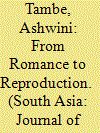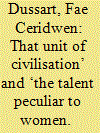| Srl | Item |
| 1 |
ID:
170470


|
|
|
|
|
| Summary/Abstract |
This essay takes up for analysis how couples were represented in the cover art of the Marathi women’s magazine, Stree, from 1935 to 1965. Stree was the longest continuously running women’s magazine in Marathi (published from 1930 to 1986) and had a strong visual identity that benefited from cover images painted by noted artists. I focus here on a contrast that is evident between how couples were represented before and after Independence. Between 1935 and 1947, the hallmark image on the covers was the romantic couple, with alluring women as central figures. After Independence, between 1947 and 1965, the romantic couple receded from view and was replaced by scenes of comfortable and responsible mothering and domesticity. Depictions of premarital romance dropped, and women became components in a household tableau rather than the focus of romantic pursuit. In contrast with the Anglicised notions of glamour used in the 1930s, we also find a more explicitly Hindu aesthetic in the frequent representations of religious rituals and weddings. I treat these changing themes as an expression of the visual idiom of nation-building in mid twentieth century India. The increasing Hinduisation of couples in Stree covers reflects a post-Partition ethos of channelling conjugality along specifically majoritarian religious lines. The shunning of frivolity and the turn towards family and nation-building in this cultural text illustrates, in effect, how nationalism can shore up and promote very segregated gender relations.
|
|
|
|
|
|
|
|
|
|
|
|
|
|
|
|
| 2 |
ID:
141468


|
|
|
|
|
| Summary/Abstract |
Domestic servants across the British Empire were instrumental in constructing colonial domesticity. In metropole and colony, they marked the physical boundaries of the house and family and the categorical boundaries of class, gender and racial difference. However, in colonial India, the gender and racial status of Indian servants, relative to both their colonial employers and their metropolitan counterparts, disrupted the dynamics of dependence that structured metropolitan employer/servant relations and identities. Despite efforts to dutifully ‘civilise’ households according to a ‘British’ standard, the day-to-day reality was one in which ambivalence and uncertainty towards servants were commonplace among colonisers and where servants participated in the creation of a way of life that was specifically colonial, even while it sought to preserve and proselytise ‘Britishness’.
|
|
|
|
|
|
|
|
|
|
|
|
|
|
|
|